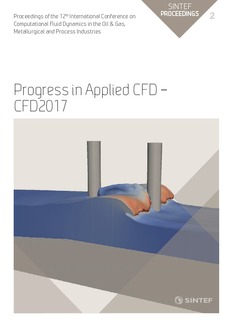| dc.contributor.author | Johnsen, Sverre Gullikstad | |
| dc.contributor.author | Pääkkönen, Tiina | |
| dc.contributor.author | Johansen, Stein Tore | |
| dc.contributor.author | Keiski, Riitta | |
| dc.contributor.author | Wittgens, Bernd | |
| dc.date.accessioned | 2018-01-29T09:16:49Z | |
| dc.date.available | 2018-01-29T09:16:49Z | |
| dc.date.created | 2017-09-22T15:17:19Z | |
| dc.date.issued | 2017 | |
| dc.identifier.isbn | 978-82-536-1544-8 | |
| dc.identifier.uri | http://hdl.handle.net/11250/2480156 | |
| dc.description.abstract | In a previous paper (Johnsen et al., 2015) and presentation (Johnsen et al., 2016), we developed and demonstrated a generic modelling framework for the modelling of direct precipitation fouling from multi-component fluid mixtures that become super-saturated at the wall. The modelling concept involves the 1-dimensional transport of the fluid species through the turbulent boundary layer close to the wall. The governing equations include the Reynolds-averaged (RANS) advection-diffusion equations for each fluid species, and the axial momentum and energy equations for the fluid mixture. The driving force for the diffusive transport is the local gradient in the species’ chemical potential. Adsorption mechanisms are not modelled per se, but the time-scale of adsorption is reflected in the choice of Dirichlet boundary conditions for the depositing species, at the fluid-solid interface. In this paper, the modelling framework is implemented as a userdefined function (UDF) for the CFD software ANSYS Fluent, to act as a wall boundary condition for mass-transfer to the wall. The subgrid, 1-dimensional formulation of the model reduces the computational cost associated with resolving the fine length-scales at which the boundary-layer mass transfer is determined, and allows for efficient modelling of industry-scale heat exchangers suffering from fouling. The current paper describes the modelling framework, and demonstrates and validates its applicability in a simplified 2D heat exchanger geometry (experimental and detailed CFD modelling data by Pääkkönen et al. (2012, 2016)). By tuning the diffusivity, only, good agreement with the experimental data and the detailed CFD model was obtained, in terms of area-averaged deposition rates. | nb_NO |
| dc.language.iso | eng | nb_NO |
| dc.publisher | SINTEF akademisk forlag | nb_NO |
| dc.relation.ispartof | Progress in Applied CFD – CFD2017 Selected papers from 12th International Conference on Computational Fluid Dynamics in the Oil & Gas, Metallurgical and Process Industries | |
| dc.rights | Navngivelse 4.0 Internasjonal | * |
| dc.rights | Attribution-NonCommercial-NoDerivatives 4.0 Internasjonal | * |
| dc.rights.uri | http://creativecommons.org/licenses/by-nc-nd/4.0/deed.no | * |
| dc.title | Implementation, Demonstration and Validation of a User-Defined Wall Function for Direct Precipitation Fouling in Ansys Fluent | nb_NO |
| dc.type | Chapter | nb_NO |
| dc.description.version | publishedVersion | nb_NO |
| dc.identifier.cristin | 1497101 | |
| dc.description.localcode | SINTEF Proceedings er Open Access etter CC BY-NC-ND-lisensen (http://creativecommons.org/licenses/by-nc-nd/4.0/). | nb_NO |
| cristin.unitcode | 194,64,25,0 | |
| cristin.unitname | Institutt for energi- og prosessteknikk | |
| cristin.ispublished | true | |
| cristin.fulltext | original | |

